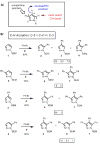C-H bonds as ubiquitous functionality: a general approach to complex arylated pyrazoles via sequential regioselective C-arylation and N-alkylation enabled by SEM-group transposition
- PMID: 19206533
- PMCID: PMC2954770
- DOI: 10.1021/ja8096114
C-H bonds as ubiquitous functionality: a general approach to complex arylated pyrazoles via sequential regioselective C-arylation and N-alkylation enabled by SEM-group transposition
Abstract
Pyrazoles are important azole heteroarenes frequently found in pharmaceuticals and protein ligands, and there has been a growing interest in new synthetic methods for their preparation. We report the first catalytic intermolecular C-H arylation of pyrazoles, namely SEM-protected pyrazoles and N-alkylpyrazoles, which lays the foundation for a new approach to the synthesis of complex arylated pyrazoles, where new arene rings are directly attached to predetermined positions of the heteroarene nucleus ("topologically obvious synthesis"). Through a systematic search, we identified a palladium-pivalate catalytic system as the most effective protocol and mapped the reactivity of all three C-H bonds of the pyrazole (C-5 > C-4 >> C-3). To circumvent the low reactivity of the C-3 position, we developed a "SEM switch", which transposes the SEM-protecting group from one nitrogen to the other in one step, and in the process transforms the unreactive C-3 position to the reactive C-5 position. The SEM switch thus enables sequential arylation of C-5 and C-3 position, providing rapid access to protected or free 3,4,5-triarylpyrazoles (the C-4 arene ring is readily introduced by bromination and Suzuki coupling). Furthermore, N-alkylation of SEM-protected pyrazoles allows for regioselective introduction of the amine substituent, addressing the low regioselectivity of N-alkylation of pyrazoles lacking sufficient steric bias. Thus, the catalytic C-H arylation combined with the protecting group transposition and N-alkylation provides a rapid route to fully substituted pyrazoles with complete regiocontrol of all substituents. The particular strength of this strategy is the ability to commence the synthesis from either the parent pyrazole or practically any pyrazole intermediate.
Figures






Similar articles
-
C-H bonds as ubiquitous functionality: preparation of multiple regioisomers of arylated 1,2,4-triazoles via C-H arylation.J Org Chem. 2013 Jan 18;78(2):738-43. doi: 10.1021/jo3021677. Epub 2012 Dec 31. J Org Chem. 2013. PMID: 23276283 Free PMC article.
-
C-H bonds as ubiquitous functionality: a general approach to complex arylated imidazoles via regioselective sequential arylation of all three C-H bonds and regioselective N-alkylation enabled by SEM-group transposition.J Org Chem. 2010 Aug 6;75(15):4911-20. doi: 10.1021/jo100727j. J Org Chem. 2010. PMID: 20608749 Free PMC article.
-
Palladium-catalyzed direct arylation of 5-chloropyrazoles: a selective access to 4-aryl pyrazoles.J Org Chem. 2012 Sep 7;77(17):7659-64. doi: 10.1021/jo301047v. Epub 2012 Aug 21. J Org Chem. 2012. PMID: 22849880
-
Beyond Friedel and Crafts: Innate Alkylation of C-H Bonds in Arenes.Angew Chem Int Ed Engl. 2019 Jun 3;58(23):7558-7598. doi: 10.1002/anie.201806631. Epub 2019 Apr 4. Angew Chem Int Ed Engl. 2019. PMID: 30107077 Review.
-
Recent highlights in the synthesis and biological significance of pyrazole derivatives.Heliyon. 2024 Oct 9;10(20):e38894. doi: 10.1016/j.heliyon.2024.e38894. eCollection 2024 Oct 30. Heliyon. 2024. PMID: 39492900 Free PMC article. Review.
Cited by
-
C-H bonds as ubiquitous functionality: preparation of multiple regioisomers of arylated 1,2,4-triazoles via C-H arylation.J Org Chem. 2013 Jan 18;78(2):738-43. doi: 10.1021/jo3021677. Epub 2012 Dec 31. J Org Chem. 2013. PMID: 23276283 Free PMC article.
-
Ligandless Palladium-Catalyzed Direct C-5 Arylation of Azoles Promoted by Benzoic Acid in Anisole.Molecules. 2022 Dec 2;27(23):8454. doi: 10.3390/molecules27238454. Molecules. 2022. PMID: 36500546 Free PMC article.
-
Redox-Neutral Vicinal Difunctionalization of Five-Membered Heteroarenes with Dual Electrophiles.Angew Chem Int Ed Engl. 2021 Dec 6;60(50):26184-26191. doi: 10.1002/anie.202110971. Epub 2021 Nov 10. Angew Chem Int Ed Engl. 2021. PMID: 34591355 Free PMC article.
-
A Robust Protocol for Pd(II)-catalyzed C-3 Arylation of (1H) Indazoles and Pyrazoles: Total Synthesis of Nigellidine Hydrobromide.Chem Sci. 2013 Jun 1;4(6):2374-2379. doi: 10.1039/C3SC50184A. Chem Sci. 2013. PMID: 23691269 Free PMC article.
-
Catalyst-free, one-pot, three-component synthesis of 5-amino-1,3-aryl-₁Η-pyrazole-4-carbonitriles in green media.Mol Divers. 2013 Aug;17(3):459-69. doi: 10.1007/s11030-013-9445-y. Epub 2013 Apr 27. Mol Divers. 2013. PMID: 23624645
References
-
- Pozharskii AF, Soldatenkov AT, Katritzky AR. Heterocycles in Life and Society. Wiley; Chichester, NY: 1997.
-
- Elguero J. In: Comprehensive Heterocyclic Chemistry. Katrizky AR, Rees CW, Scriven EFV, editors. Vol. 5 Pergamon; Oxford: 1996.
-
- Sliskovich DR, Roth BD, Wilson MW, Hoefle ML, Newton RS. J Med Chem. 1990;33:31–38. - PubMed
-
- Penning TD, Talley JJ, Bertenshaw SR, Carter JS, Collins PW, Docter S, Graneto MJ, Lee LF, Malecha JW, Miyashiro JM, Roger RS, Rogier DJ, Yu SS, Anderson GD, Burton EG, Cogburn JN, Gregory SA, Koboldt CM, Perkins WE, Seibert K, Veenhuizen AW, Zhang YY, Isakson PC. J Med Chem. 1997;40:1347–1365. - PubMed
-
- Stauffer SR, Katzenellenbogen JA. J Comb Chem. 2000;2:318–329. - PubMed
Publication types
MeSH terms
Substances
Grants and funding
LinkOut - more resources
Full Text Sources
Other Literature Sources
Miscellaneous

